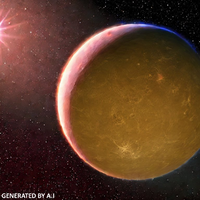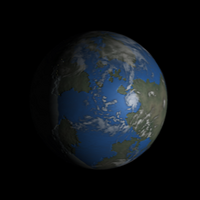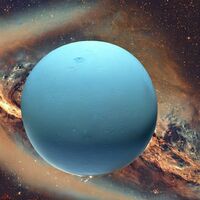Tau Lanus System: Difference between revisions
No edit summary |
No edit summary |
||
| (13 intermediate revisions by the same user not shown) | |||
| Line 52: | Line 52: | ||
|- | |- | ||
! scope='row' | [[Kelera]] | ! scope='row' | [[Kelera]] | ||
| 1. | | 1.107 | ||
| 1. | | 1.250 | ||
| 4.59 | | 4.59 | ||
| 0.05 | | 0.05 | ||
| 6.98 | | 6.98 | ||
| | | Erebus | ||
|- | |- | ||
! scope='row' | [[Cyadon]] | ! scope='row' | [[Cyadon]] | ||
| | | 14.536 | ||
| | | 4.005 | ||
| 1.27 | | 1.27 | ||
| 0.13 | | 0.13 | ||
| Line 80: | Line 80: | ||
== Tau Lanus == | == Tau Lanus == | ||
The '''Tau Lanus''' is a red dwarf star of spectral class M4V and Tau Lanus system’s singular star. In their nuclei, her convert hydrogen into helium through nuclear fusion, releasing enormous quantities of energy that is radiated out into space heating up the planets and other celestial bodies in proximity. The surface temperature is estimated at ~3800 K. The activity of the star turned out to be moderate, the frequency of flashes with a power above 1% of the average luminosity is 30 times less than that of stars of classes M6-M9. Nearest planets (Tau Lanus b and Kelera) tidally locked to Tau Lanus, meaning one hemisphere permanently face the host star. | The '''Tau Lanus''' is a red dwarf star of spectral class M4V and Tau Lanus system’s singular star. In their nuclei, her convert hydrogen into helium through nuclear fusion, releasing enormous quantities of energy that is radiated out into space heating up the planets and other celestial bodies in proximity. The surface temperature is estimated at ~3800 K. The activity of the star turned out to be moderate, the frequency of flashes with a power above 1% of the average luminosity is 30 times less than that of stars of classes M6-M9. Nearest planets (Tau Lanus b and Kelera) {{wp|tidally locked|Tidal locking}} to Tau Lanus, meaning one hemisphere permanently face the host star. | ||
[[File:Planet Tau Lanus b.png|200px|thumb|right|The image of the planet Tau Lanus b in the artist's view]] | [[File:Planet Tau Lanus b.png|200px|thumb|right|The image of the planet Tau Lanus b in the artist's view]] | ||
== Tau Lanus b == | == Tau Lanus b == | ||
The planet '''Tau Lanus b''' is the closest (0. | The planet '''Tau Lanus b''' is the closest (0.02 AU) to Star of the four planet in the system. The planet makes a revolution around the star in 2 days. Tau Lanus b has no natural satellites, but there is a very rarefied atmosphere which consists of Coronal mass ejection particles trapped by magnetic field, as well as atoms blasted off its surface by the Coronal mass ejection. The planet is tidally locked, meaning one hemisphere permanently face the star. Its daytime hemisphere is heated to 340 ° C, and in the night hemisphere there is a frost of about -250 ° C. The dominant geological features are impact craters or basins with ejecta blankets, the remains of early volcanic activity including magma flows, and lobed ridges or rupes that were probably produced by a period of contraction early in the planet's history. | ||
== Kelera == | == Kelera == | ||
'''[[Kelera]]''' or Tau Lanus c, is the second planet (0. | [[File:Kelera Artist's Impression.png|200px|thumb|right|The image of the planet Kelera in the artist's view]] | ||
'''[[Kelera]]''' or Tau Lanus c, is the second planet (0.05 AU) from the Star Tau Lanus and makes a revolution around her in 14 days. This is one of the planets colonized by the humanity, and one of the few on which life has been discovered. '''Life''' before colonization on the planet was represented by simple '''microorganisms''', '''algae''', '''fungi''' and '''lichens'''. While large amounts of water can be found throughout the Tau Lanus System, only Kelera sustains liquid surface water. Kelera's atmosphere is radically different from those of the other planets, having been altered by the presence of life to contain 19% free oxygen. The planetary magnetosphere shields the surface from cosmic radiation, limiting atmospheric stripping and maintaining habitability. However, her it one major difference - the planet is {{wp|tidally locked|Tidal locking}}. As a result, the side constantly facing the star is a massive desert, while the side facing away from the star is a frozen land. However, in-between these extremes, there are rings of habitable areas with different climates depending on how warm they are. Planetary hurricanes regularly take place on the planet, which bring dust from the daytime side, and at other times the sky constantly remains pinkish or yellow-orange. Kelera has small natural [[Kelera|satellit-asteroid Erebus]]. | |||
== Cyadon == | == Cyadon == | ||
'''[[Cyadon]]''' or Tau Lanus d (0.13 AU from the Star Tau Lanus), taking about 30 days to complete an orbit. Cyadon is an ice giant, unlike gas giants, consisting mainly of hydrogen and helium, there is no metallic hydrogen in the depths of Cyadon, but there is a lot of ice in its high-temperature modifications. For this reason, experts have classified it in the category of "ice giants". The basis of the atmosphere of Cyadon is hydrogen and helium. It has the coldest atmosphere in the Tau Lanus system, with a minimum temperature of 49 kelvins (−224 °C; −371 °F). He it has a complex, layered cloud structure; water is thought to make up the lowest clouds and methane the uppermost layer. The planet's interior is mainly composed of ices and rock. Cyadon was found to have 25 natural satellites. The four main satellites are Cyadon 1, [[Cyadon 2]], Cyadon 3 and Cyadon 4. Cyadon attracted the attention of the | '''[[Cyadon]]''' or Tau Lanus d (0.13 AU from the Star Tau Lanus), taking about 30 days to complete an orbit. Cyadon is an ice giant, unlike gas giants, consisting mainly of hydrogen and helium, there is no metallic hydrogen in the depths of Cyadon, but there is a lot of ice in its high-temperature modifications. For this reason, experts have classified it in the category of "ice giants". The basis of the atmosphere of Cyadon is hydrogen and helium. It has the coldest atmosphere in the Tau Lanus system, with a minimum temperature of 49 kelvins (−224 °C; −371 °F). He it has a complex, layered cloud structure; water is thought to make up the lowest clouds and methane the uppermost layer. The planet's interior is mainly composed of ices and rock. Cyadon was found to have 25 natural satellites. The four main satellites are Cyadon 1, [[Cyadon 2]], Cyadon 3 and Cyadon 4. The planet and its moons are located at the outer edge of the habitable zone. Cyadon attracted the attention of the humanity by the relatively easy possibility of extracting Helium-3 for thermonuclear installations. An autonomous Helium-3 mining station is located between the low orbit and the upper atmosphere, and a working colony is located on the second satellite of the Ice Giant - [[Cyadon 2]]. | ||
[[File:The image of the planet Cyadon .jpg|200px|thumb|left|The image of the planet Cyadon in the artist's view]] | |||
== Tau Lanus e == | == Tau Lanus e == | ||
'''Tau Lanus e''' (0.33 AU from the Star), taking about 124 days to complete an orbit. Since Tau Lanus e ice planet, is made primarily of ice and rock and | '''Tau Lanus e''' (0.33 AU from the Star), taking about 124 days to complete an orbit. Since Tau Lanus e ice planet, is made primarily of ice and rock. It is the smallest (0.533M🜨 and 0.618R🜨) and the most distant (0.33 au from the star) planet in the system. The planet has no satellites. Tau Lanus e's atmosphere is very thin and consists of gases evaporating from the surface ice. This is nitrogen with an admixture of methane (about 0.25%) and carbon monoxide. Average Temperature:73 kelvins (−200 °C; −328 °F). The direction of rotation around its axis in Tau Lanus e is the opposite, that is, opposite to the direction of rotation of the planets around the Star. | ||
== References == | |||
{{Reflist}} | |||
[[Category:Astronomy (Kelera)]] | |||
[[Category:Planets]] | |||
{{Kelera}} | |||
Latest revision as of 18:36, 15 July 2023
| Age | 2.559 billion years |
|---|---|
| Location | Local Interstellar Cloud, Local Bubble, White Cygnus Arm, KIX-399 Galaxy |
| System mass | 1,0015 M☉ |
| Nearest star | YZ Lanus, Star Cluster Lanus |
| Planetary system | |
| Semi-major axis of outer known planet | (Tau Lanus e) 0.33 AU |
| Distance to Kuiper cliff | ~10 AU |
Populations | |
| Known stars | 1 (Tau Lanus) |
| Known planets | |
| Identified rounded satellites | (satellites of Cyadon) List
|
| Star-related properties | |
| Spectral type | M4V |
The Tau Lanus System is a collection of orbiting celestial bodies that are gravitationally bound to the Star Tau Lanus. The Tau Lanus System began its formation 2.5 Billion years ago as a result of the gravitational collapse of a large interstellar molecular cloud. There are 4 planets in the Tau Lanus System. Tau Lanus b and Kelera are terrestrial planets composed of rock, metals, and ices. Cyadon significantly larger and more massive than the terrestrial planets, are composed primarily of gases and ices, it is ice giant. The planet Tau Lanus e is the outest planet of the Tau Lanus System which. It is ice planet, is composed primarily of ice, rock and metal. All planets have nearly circular orbits, but outer planet Tau Lanus e possess more eccentric orbit that intersect the ecliptic.
Planets
| Name | Mass (M🜨) | Radius (R🜨) | Density (g/cm3) | Semi-Major Axis (AU) | Orbital Period (🜨-Days) | Major Natural Satelites |
|---|---|---|---|---|---|---|
| Tau Lanus b | 0.825 | 0.912 | 5.72 | 0,02 | 1,93 | n/a |
| Kelera | 1.107 | 1.250 | 4.59 | 0.05 | 6.98 | Erebus |
| Cyadon | 14.536 | 4.005 | 1.27 | 0.13 | 30.09 | Cyadon 1, Cyadon 2, Cyadon 3, Cyadon 4 |
| Tau Lanus e | 0.533 | 0.618 | 1.48 | 0.33 | 123,83 | n/a |
Tau Lanus
The Tau Lanus is a red dwarf star of spectral class M4V and Tau Lanus system’s singular star. In their nuclei, her convert hydrogen into helium through nuclear fusion, releasing enormous quantities of energy that is radiated out into space heating up the planets and other celestial bodies in proximity. The surface temperature is estimated at ~3800 K. The activity of the star turned out to be moderate, the frequency of flashes with a power above 1% of the average luminosity is 30 times less than that of stars of classes M6-M9. Nearest planets (Tau Lanus b and Kelera) Tidal locking to Tau Lanus, meaning one hemisphere permanently face the host star.
Tau Lanus b
The planet Tau Lanus b is the closest (0.02 AU) to Star of the four planet in the system. The planet makes a revolution around the star in 2 days. Tau Lanus b has no natural satellites, but there is a very rarefied atmosphere which consists of Coronal mass ejection particles trapped by magnetic field, as well as atoms blasted off its surface by the Coronal mass ejection. The planet is tidally locked, meaning one hemisphere permanently face the star. Its daytime hemisphere is heated to 340 ° C, and in the night hemisphere there is a frost of about -250 ° C. The dominant geological features are impact craters or basins with ejecta blankets, the remains of early volcanic activity including magma flows, and lobed ridges or rupes that were probably produced by a period of contraction early in the planet's history.
Kelera
Kelera or Tau Lanus c, is the second planet (0.05 AU) from the Star Tau Lanus and makes a revolution around her in 14 days. This is one of the planets colonized by the humanity, and one of the few on which life has been discovered. Life before colonization on the planet was represented by simple microorganisms, algae, fungi and lichens. While large amounts of water can be found throughout the Tau Lanus System, only Kelera sustains liquid surface water. Kelera's atmosphere is radically different from those of the other planets, having been altered by the presence of life to contain 19% free oxygen. The planetary magnetosphere shields the surface from cosmic radiation, limiting atmospheric stripping and maintaining habitability. However, her it one major difference - the planet is Tidal locking. As a result, the side constantly facing the star is a massive desert, while the side facing away from the star is a frozen land. However, in-between these extremes, there are rings of habitable areas with different climates depending on how warm they are. Planetary hurricanes regularly take place on the planet, which bring dust from the daytime side, and at other times the sky constantly remains pinkish or yellow-orange. Kelera has small natural satellit-asteroid Erebus.
Cyadon
Cyadon or Tau Lanus d (0.13 AU from the Star Tau Lanus), taking about 30 days to complete an orbit. Cyadon is an ice giant, unlike gas giants, consisting mainly of hydrogen and helium, there is no metallic hydrogen in the depths of Cyadon, but there is a lot of ice in its high-temperature modifications. For this reason, experts have classified it in the category of "ice giants". The basis of the atmosphere of Cyadon is hydrogen and helium. It has the coldest atmosphere in the Tau Lanus system, with a minimum temperature of 49 kelvins (−224 °C; −371 °F). He it has a complex, layered cloud structure; water is thought to make up the lowest clouds and methane the uppermost layer. The planet's interior is mainly composed of ices and rock. Cyadon was found to have 25 natural satellites. The four main satellites are Cyadon 1, Cyadon 2, Cyadon 3 and Cyadon 4. The planet and its moons are located at the outer edge of the habitable zone. Cyadon attracted the attention of the humanity by the relatively easy possibility of extracting Helium-3 for thermonuclear installations. An autonomous Helium-3 mining station is located between the low orbit and the upper atmosphere, and a working colony is located on the second satellite of the Ice Giant - Cyadon 2.
Tau Lanus e
Tau Lanus e (0.33 AU from the Star), taking about 124 days to complete an orbit. Since Tau Lanus e ice planet, is made primarily of ice and rock. It is the smallest (0.533M🜨 and 0.618R🜨) and the most distant (0.33 au from the star) planet in the system. The planet has no satellites. Tau Lanus e's atmosphere is very thin and consists of gases evaporating from the surface ice. This is nitrogen with an admixture of methane (about 0.25%) and carbon monoxide. Average Temperature:73 kelvins (−200 °C; −328 °F). The direction of rotation around its axis in Tau Lanus e is the opposite, that is, opposite to the direction of rotation of the planets around the Star.




